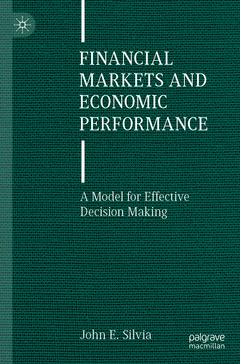Description
Financial Markets and Economic Performance, 1st ed. 2021
A Model for Effective Decision Making
Author: Silvia John E.
Language: English
Subjects for Financial Markets and Economic Performance:
Approximative price 63.29 €
In Print (Delivery period: 15 days).
Add to cartPublication date: 08-2022
453 p. · 15.5x23.5 cm · Paperback
Publication date: 08-2021
453 p. · 15.5x23.5 cm · Hardback
Description
/li>Contents
/li>Biography
/li>Comment
/li>
Effective decision making requires understanding of the underlying principles of financial markets and economics. Intellectually, economics and financial markets are genetically intertwined although when it comes to popular commentary they are treated separately. In fact, academic economic thinking appears separate from financial market equity strategy in most financial market commentary. Historically, macroeconomics tended to assume away financial frictions and financial intermediation whereas financial economists did not necessarily consider the negative macroeconomic spill overs from financial market outcomes.
In more recent years, the economic discipline has gone through a serious self-reflection after the global crisis. This book explores the interplay between financial markets and macroeconomic outcomes with a conceptual framework that combines the actions of investors and individuals. Of interest to graduate students and those professionals working in the financial markets, it provides insight into why market prices move and credit markets interact and what factors participants and policy makers can monitor to anticipate market change and future price paths. ?Chapter 1: Why Finance Matters for Economics: The Story of Financing the Railroad.- Chapter 2: The Story of the Original Boom and Bust in Western Finance: The Mississippi Bubble.- Chapter 3: Price Determination in a Multi Sector Global Economy.- Chapter 4: Credit Allocation and the Role of the Price of Credit.- Chapter 5: Short-term Credit: Financing the Consumer and Business.- Chapter 6: Capital Markets: Financing Business over the Long Term.- Chapter 7: Internal Dynamics of Corporate Finance: What’s Behind the Curtain?.- Chapter 8: Evolution of Household Finances.- Chapter 9: Global Capital Flows: Credit Allocation across Borders.- Chapter 10: Profits: Rewards and Incentives.- Chapter 11: Equity Finance: Financing Innovation and Long-term Household Wealth.- Chapter 12: Federal Government Finance: The Grand Assumption.
Explores the interplay between financial markets and macroeconomic outcomes with a conceptual framework
Emphasizes the interrelationships between four markets: goods, credit (both bank and bond market channels), equity capital, and foreign exchange
Provides insight on how to anticipate market change and future price paths




